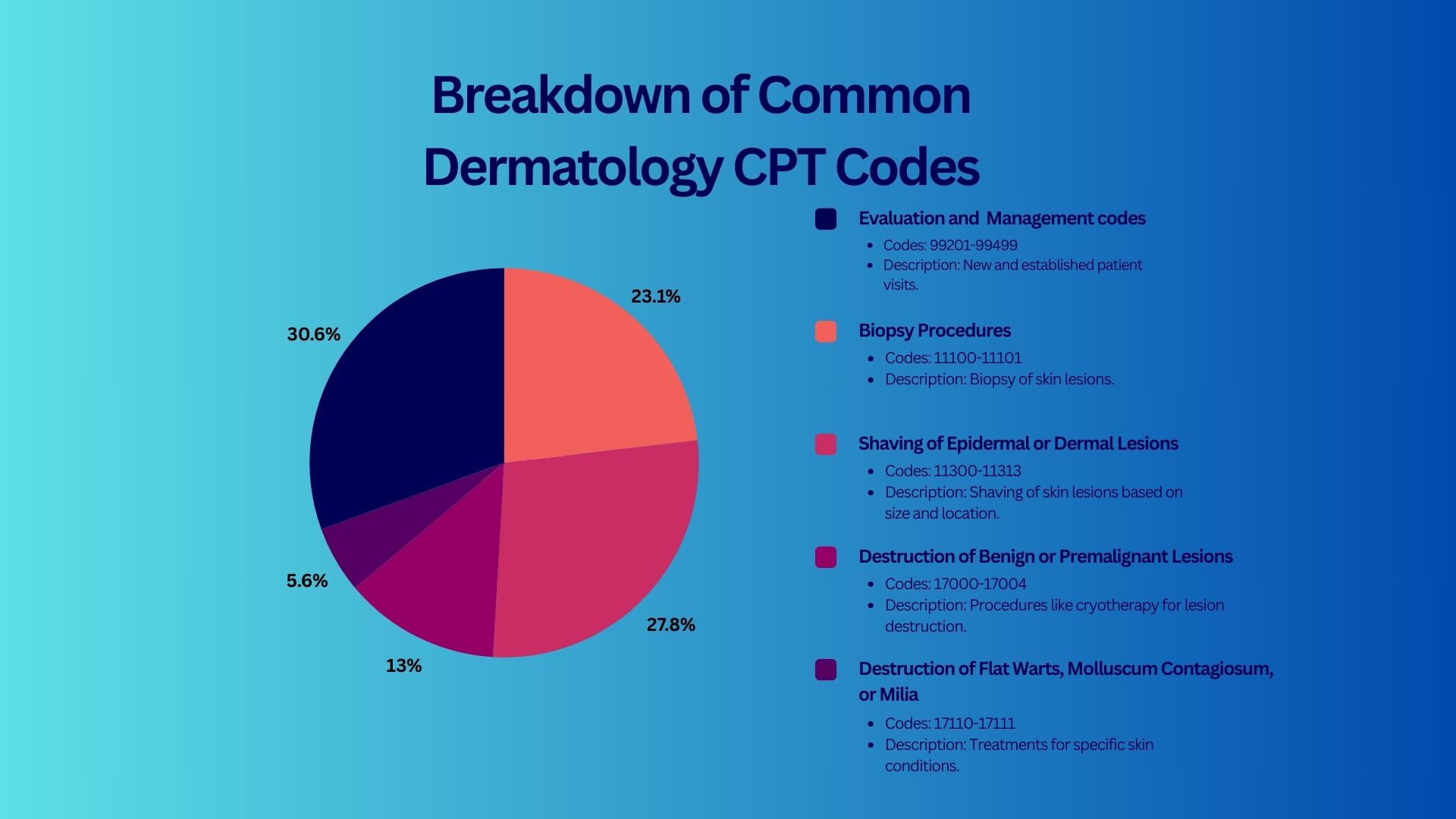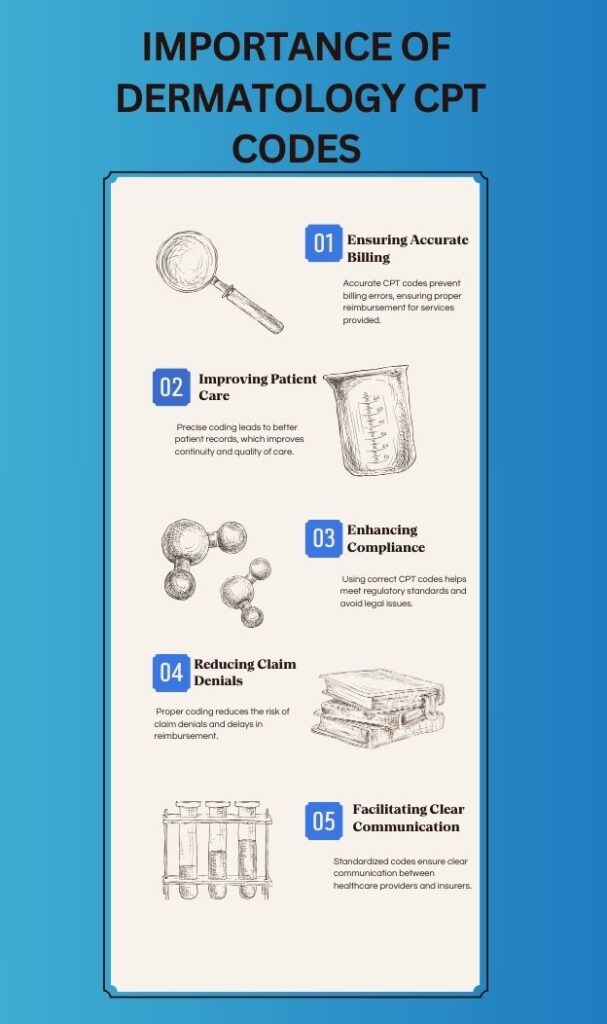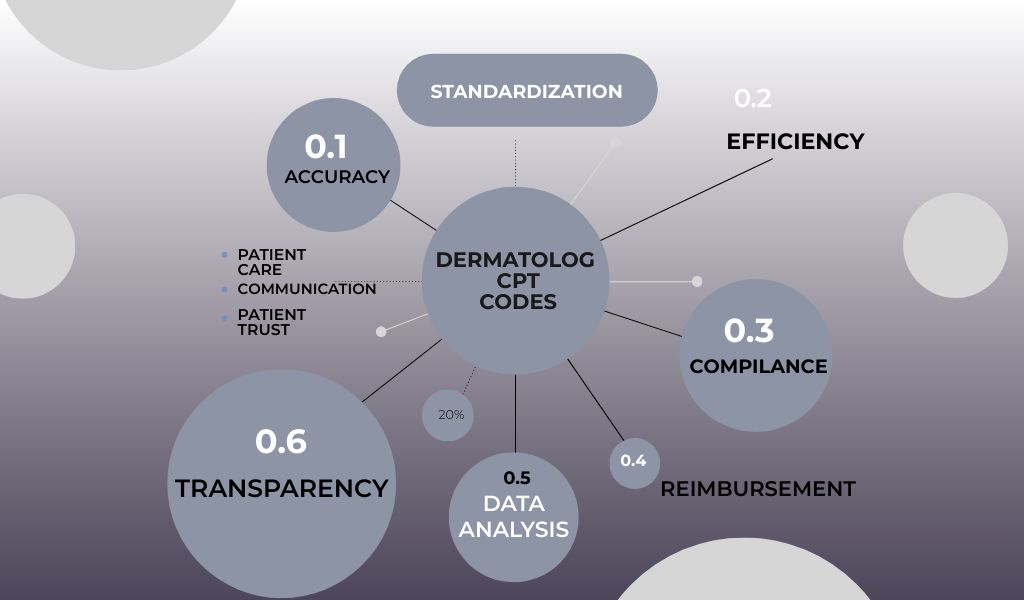The vast majority of diseases and conditions can affect the skin, which is the largest organ in the human body. Dermatology medical billing is therefore extremely intricate and subtle, necessitating staff members to become specialists in Dermatology CPT Codes and modifiers.
A thorough understanding of Dermatology Current Procedural Terminology (CPT) codes is necessary to navigate the complexities of dermatology billing. This guide delves into the intricacies of dermatology CPT codes and billing codes, emphasizing their significance and practical application.
What Are Dermatology CPT Codes?
Dermatologists use the standardized Dermatology CPT codes for dermatology to indicate surgical, diagnostic, and medical services. The American Medical Association (AMA) created these codes to help with accuracy and uniformity in the billing and documentation of dermatological services.
In order to guarantee that patients, insurance companies, and healthcare providers are all aware of the care rendered, each CPT code is assigned to a particular procedure or service.
Understanding Dermatology Billing Codes
Dermatology billing codes cover a wider range of information, such as ICD-10 codes for diagnoses and HCPCS codes for supplies and extra services, in addition to Dermatology CPT codes, which are necessary for describing procedures.
By using dermatology billing codes correctly, dermatology practices can guarantee that their bills for services are accurate, which lowers the risk of claim denials and guarantees proper reimbursement.

Your potential for revenue is ultimately impacted and financial inefficiencies result from inaccurate billing since it increases the number of rejected claims and wastes time and resources adjusting them.
Although there are hundreds of codes, you will benefit from having a list of at least 7 of the most popular Dermatology CPT codes. As a guide, you can refer to the list below:
Evaluation and Managment codes:
When billing for patient consultations, Evaluation and Management (E&M) codes are employed. These codes play a vital role in recording the care given because they encompass everything from initial evaluations to follow up appointments and foreign body removal cpt codes.
- 99211-99215: Used for established patient visits, also categorized by complexity and time.
- 99201-99205: Used for new patient visits.
Biopsy Procedures
Dermatologists frequently use biopsies to diagnose skin disorders. Skin biopsies are billed using Dermatology CPT codes 11100 and 11101.
- 11100: Used for Biopsy of a single skin lesion.
- 11101: Used for additional biopsy of skin lesions.
Accurate Coding: The Key to Better Patient Care
Shaving of Epidermal or Dermal Lesions:
In dermatology, skin lesion shaving is another common procedure. The procedures listed below are coded with CPT 11300–11313.
- The location and size of the lesion determine the code.
- Documentation and measurement accuracy are essential.
Repair (Closure) Codes:
The billing for the treatment of skin wounds is done using repair or closure codes. These codes address basic, intermediate, and advanced repairs.
- 12001-12021: Simple repairs of wounds.
- 12031-12057: Intermediate repairs, and these are more complex than simple repairs.
- 13100-13153: Complex repairs, these involve more extensive procedures.
Destruction of Benign or Premalignant Lesions:
These codes are applied to the removal of skin lesions that are benign or premalignant. They include procedures like laser treatments and cryotherapy.
- 17000: Destruction of the 1st lesion.
- 17003: Destruction of the 2nd to 14th lesions.
- 17004: Destruction of 15or more lesions.
Destruction of Flat Warts, Molluscum Contagiosum, or Milia:
Molluscum contagiosum, milia, and flat warts can all be destroyed with these codes. Cryotherapy, electrosurgery, or laser treatment are commonly used in these procedures.
- 17110: Used for destruction of about 14 lesions.
- 17111: Used for destruction of 15 or more lesions.
ENHANCE YOUR CODING KNOWLEDGE
Mohs Micrographic Surgery:
A specialist procedure called Mohs micrographic surgery is used to treat skin cancer. Billing for this meticulous and exact surgery is done using these codes.
- 17311: Used for the first stage surgery, first block.
- 17312: Used for the second stage surgery, first block.
- 17313-17315: Additional stages and blocks
Importance of accuracy in Dermatology CPT Codes

In the field of dermatology, accurate coding is crucial for operational effectiveness, patient care, regulatory compliance, and financial stability.
For several reasons, accurate CPT coding is essential in the field of dermatology. Above all, it minimizes financial disparities by guaranteeing dermatologists are appropriately reimbursed by insurance companies.
Utilizing accurate dermatology billing codes and making sure all documentation is complete greatly lowers the possibility of a claim being denied, which improves practice operations and revenue cycle management overall.
By using simple and clear billing procedures, this method not only produces better financial results but also increases patient satisfaction.
The foundation for maximizing the revenue cycle in dermatology is ultimately accurate CPT coding, which allows for quick acceptance of claims at the time of initial submission and reduces the need for expensive and time-consuming claim resubmissions.
Dermatology practices can save money and legal headaches, improve patient care, and run more smoothly by making sure that all procedures and services are appropriately coded.
Maintaining high standards in dermatological practice requires staying current with best practices and coding guidelines.
Correct skin care In order to maintain a dermatology practice’s financial stability, dermatology billing codes are essential.
It is directly related to the billing and reimbursement procedures that proper coding ensures dermatologists receive just compensation for their services.
Erroneous coding may result in payments being delayed, claims being denied, and possible audits, all of which can put a pressure on a practice’s finances.

Furthermore, accurate coding is necessary to ensure that practices comply with healthcare regulations and avoid fines and legal ramifications for incorrect billing practices.
Precise CPT coding improves patient care in ways that go well beyond the money. Better continuity of care is made possible by accurate and thorough records of the patient’s treatment history that are provided by correct coding.
Therefore, maintaining accuracy in dermatology CPT codes is essential for both providing patients with high-quality care and for a practice to run efficiently.
| Reasons for Accurate Coding | Benefits |
| Ensures proper reimbursement | The right amount of money is paid to healthcare providers for their services. |
| Decreases the number of claim rejections | Reduces the amount of paperwork and delays |
| Sustains adherence to rules and regulations | Prevents fines and legal problems |
| Improves healthcare for patients | Enhances record-keeping and care continuity |
Closing Analysis
The efficient running of any dermatology practice requires a thorough understanding of dermatology CPT codes.
Healthcare providers can guarantee patient care, obtain appropriate reimbursement, and assure compliance by accurately comprehending and utilizing these Dermatology CPT Codes.
Maintaining up to date knowledge of dermatology billing codes updates and adhering to best practices in billing will simplify the procedure and lower the possibility of mistakes, resulting in a more effective and efficient practice.
A solid understanding of these coding systems is not only helpful, but essential for dermatologists and billing personnel to successfully manage dermatology services.
FAQs
How can my dermatology practice guarantee accurate coding?
Use specific codes rather than generic ones, measure lesions precisely, stay up to date on the most recent coding guidelines, and thoroughly document all procedures to ensure accurate coding. Maintaining coding accuracy can also be aided by routine audits and training.
What effects does incorrect coding have?
Incorrect coding may result in audits, fines, legal problems, delayed reimbursements, and denial of claims. Inaccurate or incomplete medical records may also have an effect on patient care.
Which records are required in order to validate Dermatology CPT Codes?
A thorough patient history, examination results, the precise procedures carried out, lesion sizes and locations, and medical decision-making processes should all be included in the proper documentation. Extensive documentation backs up billing claims and serves to justify the selection of CPT codes.
Why is it crucial to use dermatology billing codes accurately?
Correct billing code application guarantees correct payment, lowers claim denials, boosts practice productivity, and enhances the patient satisfaction.
Why are Dermatology CPT codes used?
The documentation and billing of dermatological procedures are standardized.
- Ensure consistency.
- Enable precise invoicing.
- Encourage lucid communication.

